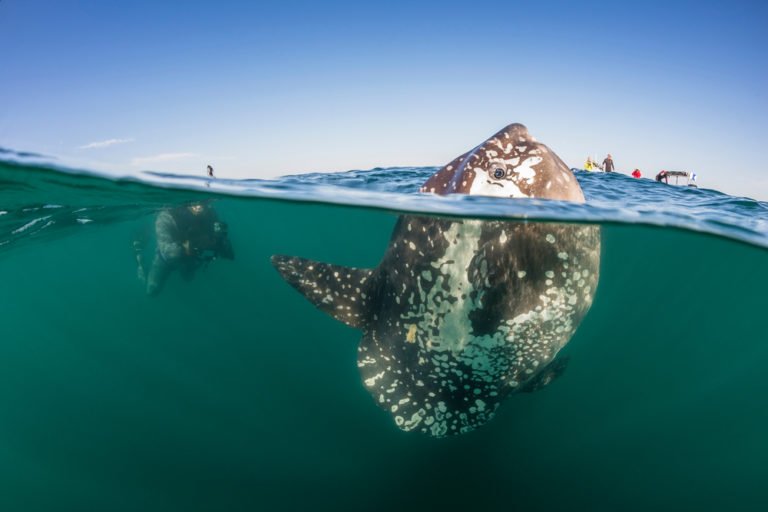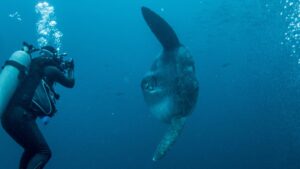Species Spotlight: Mola Mola (Sunfish)

The Mola Mola, also known as Ocean Sunfish, is an odd-looking fish. The Mola Mola is the heaviest bony fish in the world, weighing upwards of 5,000 pounds. They can grow to be over ten feet long and fourteen feet tall. The name “mola” comes from a Spanish word meaning “millstone” or “round stone” and describes the unusual, massive, round, disk shape of this fish. This unusual looking fish has no tail or tail fin. However, they are surprisingly fast in the water clocking speeds of two miles per hour. Molas can be brown, gray, white or spotted. They reside in temperate and tropical oceans around the world with the Mediterranean and Florida being two of the best places to spot one.
The Mola has four teeth fused together to form two bony plates resembling a beak. Their small mouth and lack of teeth do not hinder Mola from eating. Their bony plates suck food into their mouths condensing it into manageable bits. They feed on jellyfish, algae, and zooplankton. The Mola searches for food by making deep ocean dives into freezing waters. Unable to manage the chilly water, the Mola will lose consciousness and float to the surface.
WHERE DOES THE NAME OCEAN SUNFISH COME FROM?
Ocean Sunfish is another name for the Mola. One reason for the name Ocean Sunfish, may have come about because this fish loves to soak up the sun on the surface of the water. This creature is often seen lying on its side near the surface, basking in the sun’s rays. The Mola lays on the surface of the water to allow seabirds from the sky and fish like Reef Fish from the ocean to consume the parasites from its skin. Molas are riddled with parasites and need help getting relief. A cleaning station is a place where other animals are picking off the parasites from the Mola. It is believed that a Mola will jump up to ten feet in the air to shake off some of the parasites.
IS THE MOLA MOLA ENDANGERED?
The Mola’s conservation status is vulnerable due mostly to human negligence. They can easily be caught in sea trash and suffocate in plastic bags, which resemble their favorite food (jellyfish). Thanks to their thick skin and size, adult Molas have few predators. The natural predators of the Mola include orcas, California sea lions and great white sharks.

DIVING WITH A MOLA MOLA
Diving with Molas will provide an unforgettable memory! They are gentle and mild tempered. Divers can sometimes get within a few feet of them. Molas are not dangerous or aggressive. While the most opportune time to encounter a Mola is when they are in a cleaning station, a diver can also come across a free swimming Mola. While Molas are curious, they will leave if they perceive any signs of aggression.
Dives with these creatures are magnificent, but even more special if you observe the following important rules:
- A slow and calm tactic within its field of view is best when approaching a Mola.
- When a Mola is in the cleaning station, it is in a comatose state. During this time, the fish is relaxed and tends to ignore its surroundings. Divers should not approach the fish until the cleaning has started and the Mola has been motionless for at least 1 minute.
- When the Mola is free swimming, divers should maintain a minimum distance of 5 body lengths.
- Do not touch or feed Mola. Touching the fish can remove the mucus lining on the skin used for protection.
- Do not swim under the fish. The bubbles from a diver’s equipment will disturb the cleaning.
- Do not swim behind the Mola as this can startle the animal. Always stay in the eyesight of the fish.
For divers eager and excited to swim with a Mola, the best places to locate them are the following:
- Baja California, Mexico
- Bali, Indonesia
- Western Spain
- Inner Hebrides, Scotland, United Kingdom
- Galapagos Islands, Ecuador
These prehistoric and strange-looking fish are extraordinary and unlike anything else to see in the ocean. Any dive that includes a Mola will be a treasured experience!
